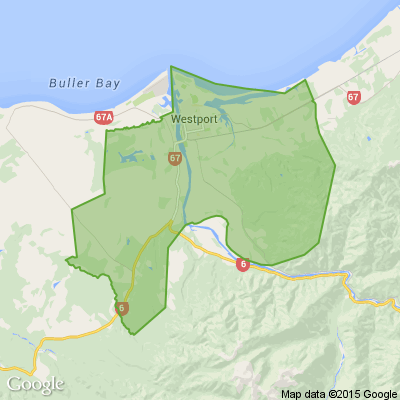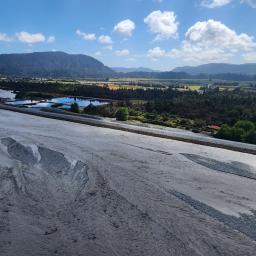Suspicious E coli levels at Franz Josef
By local democracy reporter Brendon McMahon:
E coli found at the Waiho River in January appears to be linked to seepage near a controversial stopbank and the Franz Josef sewage ponds.
West Coast Regional Council environmental consent monitoring staff detected "a spike" in E coli discharge levels to the Westland District Council's wastewater treatment cells after the Waiho River shifted course in mid-January.
The finding was flagged in council's first quarterly compliance and enforcement report for 2024.
The river began running hard up against the Westland District Council's Havill Wall, in front of the wastewater treatment plan, following a storm in January.
That event saw the Waiho River's avulsion escalate into the separate Tatare Stream catchment to the north.
The Havill Wall was controversially built following a moderate flood event in April 2016 where the river overtopped a stopbank to the north of Franz Josef township. It flooded the now abandoned Scenic Hotel site and swamped the district council's current wastewater treatment site.
The council's quarterly compliance report said the E.coli discharge to the treatment plant's disposal cells was found during regular monitoring by staff.
"Surveillance of the site found an unusual stream of water emanating from below the site," the report said.
A council compliance officer took samples of the surface water below the site.
"This was found to be contaminated with E coli bacteria.
"At the time these samples were taken the Waiho River was pushing up against the Havill Wall outside of the wastewater treatment ponds," the report said.
Subsequent additional protection work by the district council to stop the river from cutting back up towards the ponds had covered over the water sample area.
"The area sampled is now under these works."
Further inquiries were ongoing "to pinpoint" the source of the contamination.
Westland District Council chief executive Simon Bastion on April 18 said his council had been advised by the regional council an area of ponding below the level of the oxidation ponds had been sampled and found to be positive for E coli.
"The level of E coli can fluctuate in any standing or flowing water body depending on natural contamination via wildlife or human interference factors," he said.
Both councils then visited the oxidation ponds.
"A very minor clear stream of river water was visible and flowing along the toe of the stopbank and ponding near the base of Maturation pond 1. This was believed to be the cause of the positive E coli sample."
Bastion said the district council was confident its sewerage treatment ponds at the site were not permeable or posed a risk to the river.
"The new primary and secondary oxidation ponds are lined with PE (Polyethylene) to ensure they do not leak. The oxidation ponds are fit for purpose and have operated satisfactorily since commissioning in 2020."
Bastion said the final effluent disposal cells for the site were located further away from the Waiho River and complied with their Resource Consent.
The council's iwi partner, Te Rūnanga o Makaawhio, were also approached by LDR.
Makaawhio chairperson Paul Madgwick said it was the first he had heard of the incident.
Madgwick said his expectation was that council would have informed the rūnunga about the finding in the spirit of their joint agreement.
The council not keeping them in the loop undermined the formal Mana Whakahono ā Rohe agreement between Makaawhio and the council, he said.
The agreement, first signed four years ago, sets out a working relationship where council and iwi work together on resource management issues.
Regional council chief executive Darryl Lew said the E coli initially found at the site had disappeared, following more tests.
"The recent sampling is clear. That doesn't mean to say we've cleared that line of inquiry," Lew said.
He believed Makaawhio had previously been briefed about the contamination but it was a case of nothing further emerging to keep them in the loop.
However, Lew said he would communicate further.
"We certainly informed the district council."
Escherichia coli (E coli) is a bacteria commonly found in the lower intestine of warm-blooded organisms. Some E coli strain can cause serious food poisoning.
Your Christmas shopping just got easier
Mags4gifts.co.nz is having a Christmas sale with up to 40% off best-selling magazine subscriptions, including NZ Gardener, NZ House & Garden and TV Guide. Add a free e-card at checkout and schedule it to arrive on Christmas morning for a perfectly timed surprise! Make Christmas thoughtful this year with a gift that lasts long after the holidays are over.

Poll: Are our Kiwi summer holidays helping us recharge, or holding the economy back? ☀️🥝
There’s growing debate about whether New Zealand’s extended Christmas break (and the slowdown that comes with it) affects productivity.
Tracy Watkins has weighed in ... now it’s your turn. What’s your take? 🤔

-
71.9% We work hard, we deserve a break!
-
16.3% Hmm, maybe?
-
11.7% Yes!
Some Choice News!
Many New Zealand gardens aren’t seeing as many monarch butterflies fluttering around their swan plants and flower beds these days — the hungry Asian paper wasp has been taking its toll.
Thanks to people like Alan Baldick, who’s made it his mission to protect the monarch, his neighbours still get to enjoy these beautiful butterflies in their own backyards.
Thinking about planting something to invite more butterflies, bees, and birds into your garden?
Thanks for your mahi, Alan! We hope this brings a smile!









 Loading…
Loading…